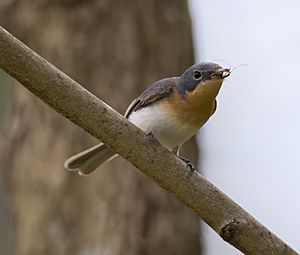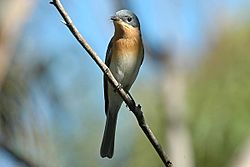Leaden flycatcher facts for kids
Quick facts for kids Leaden flycatcher |
|
|---|---|
 |
|
| Male, showing white breast | |
 |
|
| Female, with prey | |
| Conservation status | |
| Scientific classification | |
| Genus: |
Myiagra
|
| Species: |
rubecula
|
| Subspecies | |
|
See text |
|
| Synonyms | |
|
|
The leaden flycatcher (Myiagra rubecula) is a small passerine bird. This means it is a type of bird that perches. It belongs to the family Monarchidae, also known as monarch flycatchers.
These birds are about 15 cm (6 in) long. The male leaden flycatcher is a shiny blue-grey with a white belly. The female has a grey head and back, but her throat and chest are a reddish-brown color. You can find them in eastern and northern Australia, Indonesia, and Papua New Guinea. They live in warm mangrove forests and eucalypt woodlands.
Contents
About the Leaden Flycatcher's Name
The English scientist John Latham first described the leaden flycatcher in 1801. He saw a drawing of a female bird and called it the "red-breasted tody." The bird's scientific name, rubecula, comes from a Latin word. It means "robin," because of the female's reddish chest.
In some parts of Australia, like around Sydney, people call it the frogbird. This name comes from the sound of its call, which can sound a bit like a frog. Other names for it include "blue-coloured flycatcher" or "leaden Myiagra."
Different Types of Leaden Flycatchers
There are six different groups, or subspecies, of the leaden flycatcher. They live in different areas:
- M. r. sciurorum - Found on the D'Entrecasteaux Islands and the Louisiade Archipelago.
- M. r. papuana - Lives in southern and southeastern New Guinea and islands in the Torres Strait.
- Pretty flycatcher (M. r. concinna) - Found in northwestern and north-central Australia.
- M. r. okyri - This group does not migrate. It lives on the Cape York Peninsula in northeastern Australia.
- M. r. yorki - Found in northeastern and eastern Australia.
- M. r. rubecula - Lives in southeastern Australia.
What the Leaden Flycatcher Looks Like
The leaden flycatcher is about 14.5 to 16 cm (6 to 6½ in) long. It weighs around 10 to 15 grams. Its body is a shiny lead-grey color. Its wings have a brownish tint. It has a bluish-black beak, black legs, and dark brown eyes.
The male has darker grey patches near its eyes. Its chest and belly are white. The female has an orange-tan throat and chest, with a white belly. Young birds look similar to the adult female, but their wing edges are lighter.
Where They Live and Their Home
The leaden flycatcher lives in many places. You can find it from King Sound in northwestern Australia, across the northern parts (called the Top End), down to Cape York, and along the east coast to central-southern Victoria. It is rare to see them in Tasmania. These birds often travel long distances within these areas.
They prefer to live in sclerophyll forests, the edges of rainforests, mangroves, and coastal areas with shrubs.
How They Behave
As their name suggests, leaden flycatchers eat insects. They are very active and quick birds. They hop between branches and catch insects while flying in the air.
Reproduction and Life Cycle
Leaden flycatchers usually breed from September to February. They raise one group of young birds during this time. Their nest is shaped like a deep cup. They build it using strips of bark and dry grass. They hold it all together with spider webs and decorate it with lichen. Nests are usually placed on a small branch, far from the main tree trunk. They are often 5 to 10 meters (16 to 33 feet) above the ground.
The female lays two or three white eggs. These eggs might have a bluish, greyish, or lavender tint. They also have dark grey-brown spots. The eggs are about 17 mm by 14 mm and have an unusual oval shape.
Sometimes, another bird called the brush cuckoo (Cacomantis variolosus) lays its eggs in the flycatcher's nest. This is called brood parasitism. Both the male and female leaden flycatcher sit on the eggs to keep them warm. They also care for the young chicks. The female does a bit more of this work, and she also sits on the eggs at night. Sadly, not many nests are successful. Only about 23% of nests have chicks that grow big enough to leave the nest.
See also
 In Spanish: Monarca plomizo para niños
In Spanish: Monarca plomizo para niños



